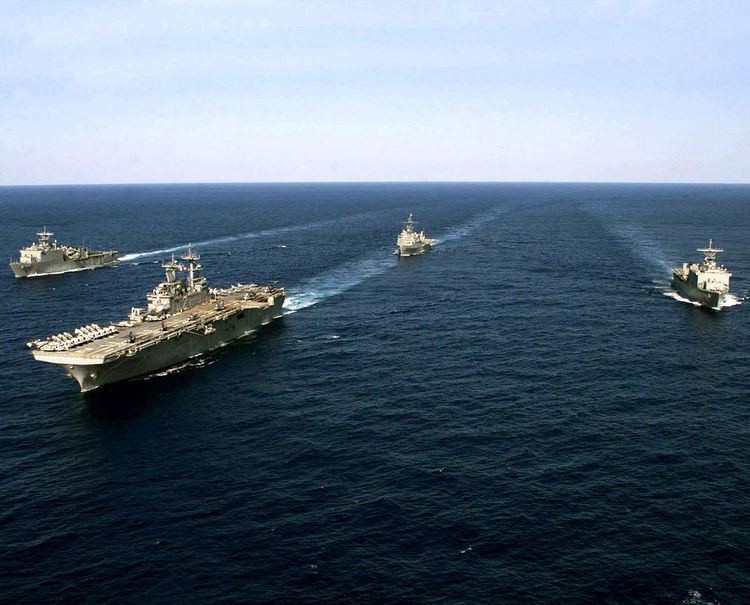An amphibious readiness group (ARG) of the United States Navy consists of a naval element—a group of warships known as an amphibious task force (ATF)—and a landing force (LF) of U.S. Marines (and occasionally U.S. Army soldiers), in total about 5,000 people. Together, these elements and supporting units are trained, organized, and equipped to perform amphibious operations.
A typical U.S. Amphibious Readiness Group consists of:
One amphibious assault ship (LHA or LHD): the primary landing ship, resembling a small aircraft carrier, designed to transport troops into the war zone by air using transport helicopters. In a secondary role, these ships perform sea control and limited power projection missions using AV-8B Harrier II Marine aircraft and Navy airborne assets including MH-60S Seahawk.One amphibious transport dock ship (LPD): a warship that transports troops into the war zone by sea, primarily using conventional landing craft and Landing Craft Air Cushion hovercraft (LCAC), although they also have the capability of operating helicopters from their flight decks as well.One dock landing ship (LSD): a warship supporting amphibious operations including landings onto hostile shores via Landing Craft Air Cushion (LCAC), conventional landing craft, and helicopters. There are currently two classes of LSDs in service: the Harpers Ferry class and the Whidbey Island class.A Marine Expeditionary Unit (MEU): the smallest configuration of a Marine Air-Ground Task Force that is deployed from an amphibious assault ship. Each MEU includes: a ground combat element of a Marine infantry battalion reinforced with M1 Abrams tanks, artillery, combat engineers, amphibious vehicles, light armored vehicles, and other ground combat assets; an aviation combat element composed of a composite squadron of rotary-wing aircraft and AV-8B Harrier II ground attack and close air support jets, and an Air Traffic Control and command and control detachment; a battalion-sized logistics combat element, and a command element. Each Marine Expeditionary Unit (MEU) typically consists of about 2,200 Marines and is usually commanded by a colonel. The makeup of the MEU can be customized as situations require; additional artillery, armor, or air units can be attached, including squadrons of F/A-18 Hornet multirole jet fighters.AV-8B Harrier IIs: ground-attack aircraft designed to attack and destroy surface targets.CH-53E Super Stallions: heavy-lift helicopters designed to transport personnel, supplies and equipment in support of amphibious and shore operations.AH-1W SuperCobras or AH-1Z Vipers: attack helicopters providing fire support and fire support coordination to the landing force during amphibious assaults and subsequent operations ashore. The newer, more capable AH-1Z is replacing the older AH-1Ws.UH-1Y Venom: Provides command and control during heliborne operations as well a light attack and assault capabilities.USMC MV-22B squadrons are designated as VMM, or Marine Medium Tiltrotor Squadron, and CH-53E squadrons as HMM, or Marine Heavy Helicopter Squadron. When assigned to a MEU, the detachments of the various other squadrons are combined with either the MV-22 or CH-53 squadron to create a reinforced, composite squadron. The reinforced squadron is designated as VMM-XXX(REIN) for MV-22s or HMH-XXX(REIN) for CH-53s, where the Xs are the squadron's number. As such, the various aircraft will don the tailcodes and markers of the VMM or HMH squadron, though will usually keep their own squadron tail art.The resulting forces may range from a single Amphibious Ready Group/Marine Expeditionary Unit (Special Operations Capable) [ARG/MEU (SOC)], to a larger organization capable of employing a Marine Expeditionary Brigade (MEB) or even a Marine Expeditionary Force (MEF).
Amphibious forces must be capable of performing missions ranging from humanitarian assistance and disaster relief to major theater war (MTW). Additionally, they can be configured and deployed to operate at various levels of conflict and in multiple theaters simultaneously. They can provide a presence that may preclude adventurous actions by a potential belligerent.
Because they are sea-based and because the decision to position and engage amphibious forces will always be easily reversible, amphibious forces greatly expand the repertoire of available response options. Among other national resources, they are particularly well placed to provide a demonstration of the United States's commitment and resolve to friends and allies as well as adversaries.
Normally two to three ARGs are forward deployed: one in the Mediterranean Sea/Persian Gulf–Indian Ocean area, and one or two in the western Pacific Ocean area. The other ships of the ARG are either working up to deploy, in transit, or in overhaul. One ARG/MEU, known as Task Force 76/Expeditionary Strike Group 7, is forward based in Sasebo and Okinawa, Japan.
In most cases, the ATF will be deployed under the protective umbrella of a carrier strike group (CSG), which provides cover for the ATF and combat support to operations ashore. Ships of the ATF are capable of embarking and supporting other forces when the mission requires, including the United States Army, Special Operations Forces (SOF), or other joint and combined forces.

